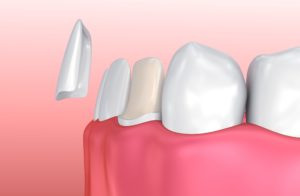 Few people are born with flawless smiles. Besides genetics, various other factors can influence the appearance of your teeth, like poor oral hygiene or previous trauma. No matter the cause, it’s easy to feel embarrassed by imperfect teeth. Thankfully, you can achieve the picture-perfect smile you deserve with porcelain veneers. Although you know they offer exceptional results, you’ll need to permanently alter your teeth. It’s normal to be concerned about how much enamel needs to be removed for veneers. Modern veneers are ultra-thin, so you’ll keep more of your tooth’s structure intact.
Few people are born with flawless smiles. Besides genetics, various other factors can influence the appearance of your teeth, like poor oral hygiene or previous trauma. No matter the cause, it’s easy to feel embarrassed by imperfect teeth. Thankfully, you can achieve the picture-perfect smile you deserve with porcelain veneers. Although you know they offer exceptional results, you’ll need to permanently alter your teeth. It’s normal to be concerned about how much enamel needs to be removed for veneers. Modern veneers are ultra-thin, so you’ll keep more of your tooth’s structure intact.
Why Does Enamel Need to Be Removed?
Your teeth are the only thing in the human body that can’t regenerate; therefore, enamel loss isn’t reversible. You need to do everything you can to keep your teeth strong and healthy, so why would you voluntarily remove enamel for veneers? There’s no reason to worry because the benefits of veneers surpass the risks.
A veneer is a thin shell that’s bonded to the front surface of a tooth. It instantly covers several aesthetic issues, like discoloration, chips, or gaps. To bond a veneer to your tooth, your dentist must etch its surface, which involves removing a small amount of enamel. It’s necessary to ensure a strong bond between your tooth and the veneer. It also allows the veneer to sit flush on your tooth for a smooth, comfortable fit.
How Much Enamel is Removed for Veneers?
Modern veneers are thinner than ever because they are typically made of porcelain. Less enamel is shaved off the tooth, making the treatment less invasive. Although every treatment plan is unique, only about 0.5mm is removed, so it doesn’t harm the health or function of your tooth. However, your teeth will always need to be covered by restorations, whether crowns or veneers, to protect the inner layers.
Your cosmetic dentist will determine exactly how much will need to be shaved down during your initial consultation. They consider numerous factors when deciding the amount, such as:
- Size and shape of your teeth
- Alignment of your teeth
- Number of issues needing to be improved
- Material of veneers
Invest in Long-Term Results
While you’ll need to remove enamel, you will enjoy lasting results because veneers are exceptionally durable. The average lifespan is about 10 to 15 years, but it’s not uncommon for them to thrive for up to 2 decades with the proper aftercare. You can ensure your new smile stays beautiful by committing to your oral hygiene at home and visiting your dentist regularly. You’ll also want to avoid anything that may damage veneers to protect your investment.
About Dr. Joseph A. Khalil
Dr. Khalil earned his dental degree from the Medical College of Virginia School of Dentistry before continuing his training in prosthodontics. He also specializes in many advanced services, like restorative cosmetic, and implant dentistry. He can create the healthy, attractive smile you desire using state-of-the-art solutions. Contact our office today to schedule your consultation for veneers.